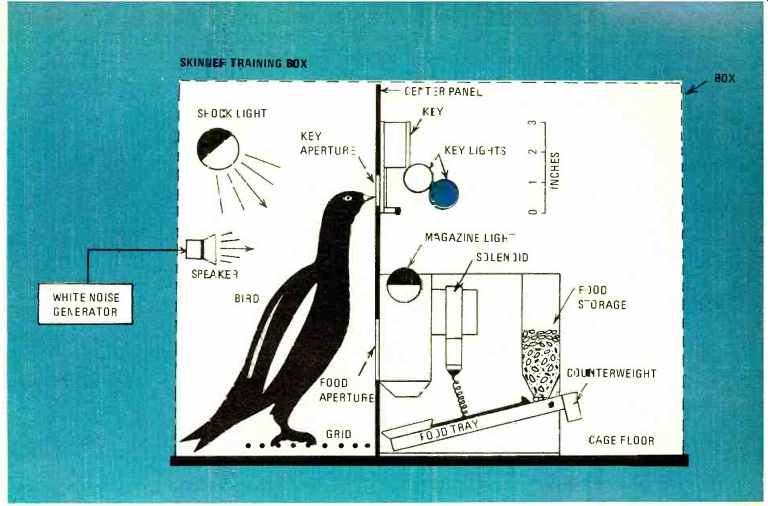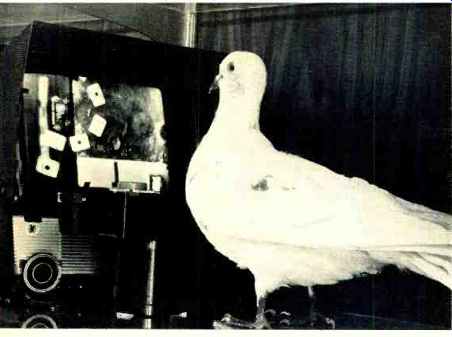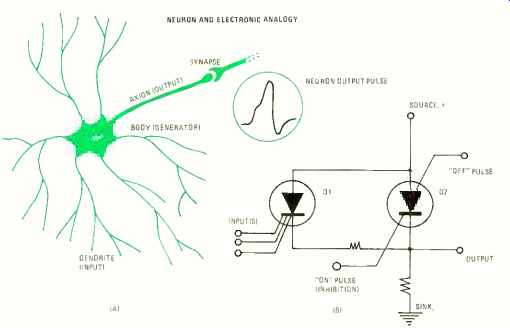(source: Electronics World, Dec. 1971)
By L. GEORGE LAWRENCE
Training cats to pilot air-to-air missiles? This is no "sci-fi" dream but is under active investigation as a means of delivering nuclear weapons via a jam-proof system which is almost impossible to detect.
In a relatively short period of time, electronics-based weapons and their delivery systems have assumed a formidable role in the defense apparatus of the great powers. Now Rand Corporation's "Soviet Cybernetics Review" has reported an odd variation: Russian technologists, says Rand, are studying the feasibility of training cats to pilot air-to-air missiles right to their targets! Although such possibilities are acknowledged both here and abroad, their application to armed conflict is, startling. Provided that suitable instruments, including support electronics, are available, small animals can be trained to execute near-perfect control of production equipment and nonflammable guidance of weapons. But such duties, alien as they are, also pose the ethical question of our right to convert a lower creature into an ill-paid laborer or unwitting hero. Unfortunately, in times to come, the question of human survival might preclude a more compassionate alternative.

Fig. 1. Typical Skinner training box.
Feeding and cueing mechanism are housed in one side of the box while the bird lives on the other side. White noise masks out environmental disturbances.
Lights are used in various ways to give cues.

Fig. 2. Training station using TV-type display methods. Optical images
are picked up and superimposed by TV camera which scans prepared pictures
and cues; then bird reacts.
Skinner Methods
Almost any sentient creature can be trained in the Skinner box, diagrammed in Fig. 1. A typical unit consists of two chambers, one of which constitutes the actual training area (for a pigeon, in this case) and the other containing the various control, cue, and feed mechanisms for reinforcing the animal's "lecture." This arrangement was developed by behavioral psychologist Dr. B. F. Skinner, an outstanding authority on human and animal learning processes.
To make our living example, the pigeon, suitable for training, it is first fed a minimal diet until its weight is reduced by 20 percent. It is then put into the training box where an ample supply of water is always available. Training begins by flashing one of the two key lights behind the key aperture. Now, after a tune, the pigeon will peck the key (a Microswitch), thereby activating the solenoid which pulls up the food tray to the simultaneously lighted food aperture. Thus, the animal learns to associate light of a given color with pecking and a consequent reward--food.
Once these initial steps have been learned, the Skinner box can be programmed--either manually or by computer--for the execution of more complex tasks. For example, the pigeon can be taught to peck only when the light is red or to expect to be fed only after it has made two or more bodily turns in the cage, etc.
As the training situation becomes more complex, the animal becomes aware of incidental cues-such as the ticking of clocks, external noises, and the like. Here, the internal volume of the Skinner box can be acoustically neutralized by radiating into it white noise at low dB levels. Also, if the pigeon makes errors in, say, tasks involving pattern recognition, it is "punished" by suddenly turning off a white shock light inside the chamber.
Fig. 2 shows a television-type training arrangement confronting a "postgraduate" bird. Developed by the author for demonstration purposes, the display shows stationary and /or moving objects which contain a set of visual cues and superimposed images. The reinforced reward situation is maintained and expanded when the animal makes its peck at the control key (thereby receiving food). It is on the basis of these and similar techniques that a massive set of skills can be taught to a pigeon-here assuming the form of an organic computer of enormous reliability, yet costing $1.50 or less.

Fig. 3. Proposed animal-guidance system for ICBM. Initial target data
is acquired by photoreconnaissance satellite. System operates with superimposed
images and can't be jammed.
Control and Guidance Performance
In 1964, Drs. R. J. Herrenstein and D. H. Loveland performed experiments to determine complex visual concepts in the pigeon. (These birds are superb all-around subjects thus their selection.) The test series showed clearly that pigeons had the unique ability to look for and react to the images of people. The birds were allowed to look at projection slides in which human beings were obscured by cars, trees, window frames, and the like. This fascinating experiment, which also involved tasks of categorizing and complex rules for sorting out pictorial elements, produced evidence of animalistic conceptualization. But this experiment does not stand alone. Even in the study of instinctive behavior with creatures low in the phyletic scale, there is overwhelming evidence of discrete sorting and generalizing.

Fig. 4. The cortical bioelectric responses of a cat's brain. The task
remains of eliciting the electronic analog profiles which correspond to
the specific stimulus patterns appearing on the target matrix.
Visual conceptualization and the motor activity triggered by it is one of the most sought-after goals of computer designers. Unfortunately, at present, this type of artificial electronic intelligence has eluded designers and remains an innate capacity of living organisms.
Dr. T. Verhave's experiments are a good case in point. Working for a large pharmaceutical company as a psycho-pharmacologist, he conceived the idea of using pigeons as quality-control inspectors. The company made gelatin drug capsules about 20 million units per day-and sorting out "skags" or defective capsules was an involved and costly process.
The drug capsules were brought into the bird's view by means of a moving belt and, through inspection windows, examined for defects. Skags made up about 10 percent of all the capsules on the belt. Reinforcement (feeding) was applied only when the bird made an appropriate number of pecks on the window-key. Wrong pecks, either misses or false alarms, were not rewarded and caused a 30second blackout inside the pigeon's work box. However, although results were excellent, Verhave's concept was not adopted. Fears of adverse publicity and similar interferences kept it from being used on a routine basis. The problem, it seems, is that the average layman thinks of inspecting birds as animals scratching with their feet in a pile of drug capsules, picking one up now and then--and, worse yet--forgetting their bathroom manners every so often.
Some 30 years ago, one of the strongest scientific objections raised against animal-equipped missile-guidance systems was that of adequate feedback control. Further, it was thought that in an actual combat situation, an animal-type weapons pilot would become irritated (perhaps get airsick) and, thus, doom the mission.
Most of these objections have now been overcome.
Toward the end of World War II, Skinner and his assistants initiated a research program called "Project Pigeon." It had a peacetime counterpart at the Naval Research Laboratories as "Orcon "-- an acronym of the words "organic control." Both of these programs have now been declassified.
Skinner's was a kind of majority-vote bombardiering system directed against ships. The missile, a simple airborne vehicle named "Pelican," was designed to use three harnessed pigeons trained by his methods. Three animals were to be used on the theory that at least two would peck correctly on the left or right of a target screen. Again, in spite of excellent results, the system was never put into operation. The Manhattan Project and its atomic bomb came along, which eliminated-as it seemed at that time-the need for pinpoint bombing. However, the fact remains that animal-guided weapons systems cannot be jammed, either electronically or by other conventional means. Once trained, as Skinner implies in his reports, a given animal tends to retain its "data" so well that it can be recalled at will even if the creature has been freed from its laboratory environment and is allowed to go on free flight again.
There is no "obsolescence." It is for these and other reasons that dynamic combat schemes, such as that shown in Fig. 3, have emerged.
This weapons system is best understood by considering it as a composite. Its principal components are (1) a photo-reconnaissance satellite, (2) a radar system, and (3) an animal guided ICBM. The elements of target data are generated in peacetime and, more narrowly, in times of war. During overflights of enemy territory, the satellite uses infrared and other photographic methods to produce film of ground targets at a selected focal length. Then, by using Skinnerian conditioning techniques, the animal weapons pilot learns to recognize specific target features which are presented to him, together with moving-ground images, by means of superimposition in an optical display system. Thus, during actual target runs, the pilot will peck (in the case of a pigeon) the appropriate guidance keys until the vehicle makes suitable vernier maneuvers to achieve perfect image superimposition or "target zero." As the target grows in optical magnitude, the superimpositions are kept in plane and, finally, a ballistic is selected which ensures a bulls-eye target run. At that time barometry takes over and senses the proximity of the target by evaluating the outside air pressure. Simultaneously, the chemical detonators are activated and, on command from the barometer sensor, initiate fission of the nuclear warhead.
As shown in Fig. 3, a weapon of this type is vulnerable to enemy countermeasures only as long as it receives initial guidance in the radar's guidance slot. Once the missile leaves the electronic horizon and enters the geodetic horizon under animal control, effective defense against it is no longer possible-at least not with the crude anti-missile weaponry available today. Indeed, it is one of the most formidable war machines the human mind can conceive-for better or worse.

Fig. 5. Neuron and electronic analogy. At (A) the neuron cell receives
inputs via dendrites. At (B) functions may be simulated artificially by
electronic neuron cell. Refer to article.
Biodynamic Guidance Systems
We mentioned the cat-guided missile scheme at the beginning of this article. It might appear, at first glance, to be little else but science-fiction, but it is dangerously more than that.
Typically, when thoughts turn to animals and guidance systems, we are inclined to envision a complete living thing-body, legs, skin, and a complete set of internal organs. This holds true of a lightweight creature like a pigeon, or perhaps a rat or mouse. There is little difficulty in providing long-term or stand-by life-support systems for them, even within the cramped space of an ICBM. But animals such as mature cats, dogs, pigs (excellent performers), horses, and other large creatures, have larger brains and neuronal network capacities. The large brain can be electronically manipulated and is less inclined to die rapidly if its nutrient bath becomes disturbed. Thus, the designer focuses on the removed brain only, rather than considering an animal's composite body and its requirements.
But, as he works with neurophysiologists to determine specific centers of data storage and correlation within an animal's severed brain, he encounters the difficulty of having no motor responses to stimulus. Data is expressed in the form of electronic products, only typically in the form of rising and descending voltages as one finds in man made computers. There also are so-called "artifacts" or phenomena which are still unexplained.
Drs. Albe-Fessard and Rougeul provided excellent electronic data on the cortical responses of a cat's brain in 1958. However, it was most difficult to detect evoked potentials from non-specific areas of the cerebral cortex in awake animals. Further, it was difficult, and in some cases almost impossible, to extract signals from noise.
Fig. 4 shows a set of cortical responses. The animal was kept under light chloralose anesthesia. The entries LAL pertain to the left anterior leg, RAL identifies the right anterior leg. So-called secondary evoked potentials (SEP) disappear under barbiturate anesthesia--but, for reasons unknown, the application of chloralose has the odd effect of synchronizing and enhancing them. This brings us to the fine-constituents of organic brains and their synaptic transmission properties.
What is desired here is that an animal brain's data-processing system can clearly recognize and provide responses when exposed to stimulus in a "target matrix" such as shown to the left in Fig. 4.
Living brains are composed of neurons. Shown in simplified form in Fig. 5A, the biological neuron is essentially a binary or digital threshold device whose output is "all-or-none "--1, 0 respectively. Its inputs, of which there can be as many as several thousand, are called dendrites. Actual signal processing takes place in the neuron's central body.
Most dendrites are excitatory systems, that is, signals passed on by them cause the central cell body to "fire." Other dendrites have inhibitory properties: signals appearing on them keep the cell from firing. Thus, the neuron's electronic status, "1" or "0," at any given instant is determined by the combination of signals appearing on the dendrites. If there are enough excitatory signals present, the cell threshold is exceeded and the neuron fires. Likewise, if too many inhibitory impulses are present, more excitatory signals are required to exceed the firing threshold.
These electronic characteristics allow us to consider the binary analog circuit shown in Fig. 5B. This "artificial neuron" is comprised of the multi-gate SCR, D1 and thyristor, D2. Because these diodes know no intermediate states of conduction like a transistor or normal vacuum tube does, the dynamic conditions of "on-off” can be established and maintained by applying appropriate trigger pulses to D1 and D2. Note that this is a simplified circuit in which zener-type threshold components have been omitted for clarity's sake.
However, although circuits of this type are being used in the relatively new field of bionics and represent progress in the art of self-organizing computer systems, it still is most difficult to transfer such analogies to real life organic controls.
If we believe the principles set forth by St. Thomas Aquinas in his book Summa Theologica, true intelligence be it that of machines or living organisms-must have these components: passive (intellectus possibilis); active (intellectus agens); and will. It is unfortunate for our experimental animals that only they, next to ourselves, have the very features which suggest their employment on behalf of man's survival.
In conclusion, it can be stated that we are on the threshold of a new if undesirable art. The Skinnerian methods are being refined and updated, typically by augmenting them with sophisticated electronic gear. However, it appears that the problem of using animals' brains directly in guidance systems have not yet been solved to the complete satisfaction of those who plan to use them. Organic brains without life-supporting baths and circulating nutrients (blood) tend to die within 10 minutes or less. Thus, until this problem and others have been solved, it is safe to assume that Columba Domestica--the common pigeon--will receive its draft call.